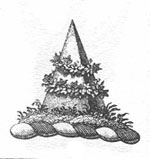
The Malcolm Clan/Family
Written and Researched by Margaret Odrowaz-Sypniewska
Bachelor of Fine Arts
 Music playing is called "The Rowan Tree" from Bagpipes At Best |
 ...
...

Motto: In ardua petit (He aims at difficult things)


The Rowan Tree (Sorbus aucuparia) "is similar to the American Mountain-ash but it has smaller, bluntly pointed leaflets, 0.8 to 2 inches long and 0.5 to 0.8 of an inch wide, often somewhat hairy below. It used as an ornamental in North America" (Brockman, Frank, A Field Guide to Identification: TREES of North America. New York: Golden Press, 1968, 164).
The Maccallums derive their name from "Mac Ghille Chaluim," "son of the disciple of Columba." Another version is that it is from the Gaelic word calaman which means "dove." The dove represented the Holy Spirit in Christianity. Calaman translated into Latin is
columba. St Columba was the Irish saint who established the monastery on Iona Isle in Scotland.
Early followers of Columba "maol Chaluim" ... which eventually became the surname Malcolm. They settled in Lorn, probably towards the end of the thirteenth century. "Maol" or "shaven head," became synonymous in Gaelic for "monk," and thus "Maol Chaluim" can be translated as "monk," or "disciple of Columba," and four Scottish kings carried this name:
- Malcolm I (943-954) second cousin of Consatantine II.
- Malcolm II (1005-1034) - Malcolm had no sons, so the succession passed through his eldest daughter Bethoc. Her son, Duncan, was to be his heir.
- Malcolm III (1058-1093) married (1) Ingibiorg of Orkney (2) Margaret of England/St Margaret. He had a son named Malcolm by his first wife. His heirs by wife one were: Duncan, Malcolm, Donald, and a daughter.
By By his second wife Margaret he had Alexander, David, Edgar, Edmund, Edward, Matilda, and Mary.
- Malcolm IV (1153-1165) was unmarried. He was the grandson of David I (son of Earl Henry). This Malcolm was nicknamed "the Maiden" because he was fair haired and fine featured. Malcolm IV took a vow of celibacy. But some think he might have fathered a bastard son. Malcolm was a patron of the Church. He founded the Abbey of Coupar Angus with monks from Melrose. He gave land to the monks of Dunfermline located in South Queensferry and land between the Forth and the Tay.
Maccolumb is recorded in a charter of 1094 (Way, George, Scottish Clan and Family Encyclopedia New York: Barnes and Noble, 1998).
Dr. Ian Grimble noted in his book Scottish Clans and Tartans that Maccullum and Malcolm are separate names. Malcolm appears as a surname in Dunbartonshire and Stirlingshire as early as the fourteeth century.
Between 1189 and 1214, the spelling of Malcholum occurs (Kelso,139)
Another Malcomessone/Malcomson was listed on the Ragman Rolls of 1296. He was Symond Malcomeffone (f's = s's) and was from the County of Berwickshire. Malcomson is regarded as a sept (sub-brnach) of the Malcolm/MacCallum clan.
Maolchalium was the first full form of the modern Malcolm. This spelling was
used in some families until the seventeeth century.
From 1189-1214 Malcholom was used.
From 1247-1264 Malcholoni is found.
In 1256, Malcolumb, a native of Scotland, was charged with murder and robbery before an assive at Newcastle-0n-Tyne. This English town was built by Henry II (1154-1189)on the site of a forress built by the eldest son of William the Conqueror, in 1080. It was located between the Tyne River and Hadrian's Wall.
Edward I walled this city which was defended against the Scots. Charles I (1625-1649) was imprisoned here for nine months, until he was "sold" to the English in 1647.
John Malcolm of Balbedie, Lochore, and Innertial was granted a charter of the Barony of Balbedie and Lochore in 1662. He had three Sons:
The Ragman Rolls of 1296, showing those who pledged their loyality to Edward I, "the hammer," included the following Malcolms:
The surname Malcolm is associated first with Dunbartonshire and Stirling, in the 14th century, and later with Dumfrieshire. In the reigns of David II (1329-1371) and Robert II (1371-1390), we find charters granting lands to Malcolms in Stirlingshire. In the 18th century a George Malcolm had three sons who were members of the Order of the Bath. Two of his sons were generals and one was an admiral. General Sir John Malcolm was the British representative in the court of the Shah of Persia and published a history of Persia in 1815. His brother Admiral Sir Pultney Malcolm commanded St Helena during Napoleon's exile there after teh Battle of Waterloo.
Malcolm Arms:
My grandfather, William Clark Malcolm came to the USA, from Fifeshire, Scotland, in the early 1900's. He settled in Detroit, Michigan. This is where my Malcolm line begins.
In older records, Malcolm is often listed as Callum. There is a debate as to whether the Malcolms and MacCallums are from the same stock, most think they are. The earlier genealogy of Malcolm can be traced to the year 1450.
Sir Duncan Campbell, of Lochow, was said to have granted his land in Craignish (on the banks of Loch Avich) to Reginald MacCallum of Corbarron in 1414. Sir Duncan was the hereditary constable of the castles Lochaffy and Craignish. Corbarron was given to the last of the family, Zachary MacCallum of Poltalloch.
"The MacCallums were in Poltalloch previous to 1562, and Duguld MacCallum of Poltalloch, who suceeded to the estate in 1779, is said to be the first to adopt the name Malcolm permanently" (Bain, Robert, The Clans and Tartans of Scotland. Glasgow: Fontana/Collins, 1985, 232)
My Malcolm Family:


Home
Owner: Raymond Sypniewski, B.S., M.A.
Email Margaret: Margaret
This page was last updated on December 30, 2007
